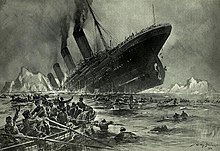Titanic in popular culture
This article has multiple issues. Please help improve it or discuss these issues on the talk page. (Learn how and when to remove these messages)
No issues specified. Please specify issues, or remove this template. |

RMS Titanic was a passenger liner that became infamous for its collision with an iceberg and dramatic sinking in 1912. It has been featured or referenced in many works.
Language
The Titanic sinking has become the best-known seafaring disaster and therefore an archetype for a disaster involving multiple casualties, which might not necessarily involve ships. The metaphor "rearranging the deckchairs on the Titanic", meaning making trivial changes when a fundamental change of course is needed, has come into common usage.
Literature

The sinking of Titanic has been the basis for many novels describing fictionalised events on board the ship. Many reference books about the disaster have also been written since Titanic sank, the first of these appearing within months of the sinking. Survivors like Second Officer Charles Lightoller and passenger Jack Thayer have written books describing their experiences. Some like Walter Lord, who wrote the popular A Night to Remember, did independent research and interviews to describe the events that happened on board the ship.
Morgan Robertson's 1898 novella Futility, or the Wreck of the Titan, which was written 14 years before RMS Titanic's voyage, was found to have many parallels with the Titanic disaster; Robertson's work concerned a fictional state-of-the-art ocean liner called Titan, which eventually collides with an iceberg on a calm April night while en route to New York. Most of those aboard die because of the lack of lifeboats. Both Titan itself and the manner of its demise bore many striking similarities to Titanic and its eventual fate, and Robertson's novella remains in print today as an unnerving curiosity.
In 1976 author Clive Cussler wrote Raise the Titanic, which documented attempts by Soviet and British spies to raise the titular vessel in order to recover its secret stash of atomic plutonium.
Television
- The Doctor Who episode The Voyaged of the Dammed features a Voyager touring space ship that is both modeled and named after the RMS Titanic. Coincidentally, the ship is hit by meteorites and "sinks" trough space towards Earth in a plan by the ship's owner to get insurance, possibly a reference to the theory that the RMS Titanic was sunk on purpose for the same reasons.
- The Futurama episode A Flight to Remember has the main characters go on a trip in space on a starship named the Titanic. The ship gets torn in half and destroyed by a black hole at the end of the episode. The whole episode is a parody of James Cameron's film, while the title is a homage to Walter Lord's book A Night to Remember.
Films
RMS Titanic has been featured in a large number of films.
Video games
- Titanic (1984) by R&R Software Ltd.[1]
- Beyond the Titanic (1986) by Apogee Software.[2]
- R.M.S. Titanic (1986) by Electric Dreams.[3]
- Titanic (1989) by Topo Soft.[4]
- Search for the Titanic (1989) by CRL.[5]
- Titanic Blinky (1991) by Zeppelin Games Ltd.[6]
- In 1996 Cyberflix made a point-and-click adventure game, called Titanic: Adventure Out of Time, which sees the player travelling around a virtual representation of the Titanic.
- Starship Titanic (1998) by Douglas Adams.
- Hidden Expedition: Titanic (2006)
- 999: Nine Hours, Nine Persons, Nine Doors
Art
- Kit (2009)[7]
Fictionalised Deaths
The total number of named fictional characters whose lives ended on the Titanic exceeds the total number of actual victims by 17.[8]
References
- ^ Titanic at SpectrumComputing.co.uk
- ^ http://www.dosgamesarchive.com/download/game/200
- ^ Lemon64: R.M.S. Titanic
- ^ Titanic at SpectrumComputing.co.uk
- ^ Lemon 64: Search for the Titanic
- ^ Titanic Blinky at SpectrumComputing.co.uk
- ^ http://www.belfasttelegraph.co.uk/community-telegraph/east-belfast/news/public-sculpture-unveiled-at-the-titanic-quarter-14549198.html
- ^ Michele Hilmes & Jason Jacobs, The Television History Book (Television, Media & Cultural Studies) (BFI Publishing, 2003),p.93.
